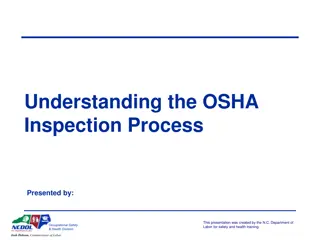Understanding Non-NRTL Equipment Inspection and Certification
Non-NRTL equipment refers to electrical components lacking NRTL certification. The article discusses recognizing non-NRTL equipment, documentation required, and hardware inspections for safety and compliance. It emphasizes factors like certification markings, manufacturer information, and product documentation. Proper visual, electrical, mechanical integrity, and compliance assessments are crucial in ensuring safety and adherence to standards.
- Non-NRTL equipment
- Electrical safety
- Equipment inspection
- Compliance assessment
- Certification requirements
Download Presentation

Please find below an Image/Link to download the presentation.
The content on the website is provided AS IS for your information and personal use only. It may not be sold, licensed, or shared on other websites without obtaining consent from the author. Download presentation by click this link. If you encounter any issues during the download, it is possible that the publisher has removed the file from their server.
E N D
Presentation Transcript
Non-NRTL Equipment Non-NRTL Equipment Equipment - Equipment Registrations (jlab.org) 8/20/2024
What is defined as Non-NRTL equipment? Non-NRTL(Nationally Recognized Testing Laboratory) equipment refers to electrical or electronic components that have not been tested, certified, or approved by a nationally recognized testing laboratory. These components lack the official validation or certification that ensures they meet specific safety and performance standards set by regulatory bodies or industry standards organizations. 2
How to recognize non-NRTL equipment? Non-NRTL equipment can be recognized by several factors: 1. Lack of Certification Markings. NRTL-certified equipment typically carries specific markings or labels from the test laboratory, such as CSA (Canadian Standards Association), or ETL(Intertek). Non-NRTL equipment may not have these markings. A complete list can be found https://www.osha.gov/nationally- recognized-testing-laboratory-program/current-list-of-nrtls 2. Manufacturer Information. Checking the manufacturer s documentation or website can provide information about whether their equipment has undergone NRTL testing and certification. UL(Underwriters Laboratories), 3. Product Documentation. Official product documentation should mention any NRTL certifications or testing that the equipment has undergone. Non-NRTL equipment may lack such documentation or may not mention any certification. 3
What documentation is required? Electrical/electronic schematics ,wire diagrams or drawings. Bill of materials (BOM). Manufacturer documentation. Testing documentation. 4
What inspection of hardware is required? Visual inspection. o Check for exposed wires. o Inspect labels, markings, and nameplates to verify important information such as voltage ratings manufacturer details and model numbers. o Ensure that all components are securely fastened and properly assembled. Electrical safety inspection. o Verify proper grounding and bonding of electrical components. o Inspect power cords, plugs, and connectors for wear, damage, or signs of overheating. o Check for adequate insulation and protection against electrical hazards 5
What inspection of hardware is required? (contd) Mechanical integrity inspection. o Verify that moving parts operate smoothly and without excessive vibration. Compliance assessment inspection. o Compare the equipment against applicable standards, regulations, and industry guidelines to ensure compliance. o Address any non-compliance issues identified during the inspection and take appropriate corrective actions. 6
Multiple components or equipment Multiple units of equipment that are precisely the same, may have 1 set of documents uploaded for all pieces. All units must be entered separately specifying the unit s individual location. 7























